March 2020
By Dennis J Weatherall JP TM AFAITT(L) LSM – Volunteer Researcher
Dennis Weatherall attended the recent 78th Anniversary of the Bombing of Darwin, also known as the “Battle of Darwin”, by Japanese Imperial Forces on Thursday 19th February 1942. The air raid siren sounded at exactly 09:58 – war had arrived in Australia. He asks why more Australians don’t know about the continuous attacks that started on that day and continued until 12th November 1943 – some 21 months. In this paper Dennis provides and overview of the attacks and naval losses in more detail.
Darwin, has changed much since my last visit some 38 years ago and it is dramatically different to the Darwin of 1942 which bore the brunt of the first ever attack by a foreign power on Australian soil. Why didn’t we know they were coming? Was our intelligence so bad or were we too complacent in 1942?
The Government of the day had anticipated the Japanese would push south but “when” was the big question. Evacuations of civilians had already started by February 1942.
On the morning of the fateful day there were many ships, both Naval and Merchant men, in the Port of Darwin along with a QANTAS flying boat “Camilla” and three Consolidated PBY Catalina flying boats of the USN, when 188 Japanese aircraft of various types, 36 Zero fighters, 71 dive bombers and 81 medium attack bombers commenced their first raid. These aircraft were launched from four Japanese Imperial Navy Aircraft Carriers namely Akagi, Kaga, Soryuand and Hiryu from 400 kms northwest of Darwin. In all there would be 64 such raids on the Top End.
For further details on the Japanese air raids across northern Australia, that stretched as far east as Townsville QLD, south in the NT to Katherine and to Exmouth on the WA coast, view the following hyperlink; http://en.wikipedia.org/wiki/Air_raids_on_Australia,_1942%E2%80%9343 There were another 62 raids, some doubling up with two targets on the same raid, with special interest on the airstrips in and around Darwin and ‘down the track’.
Father John McGrath of the Sacred Heart Mission on Bathurst Island was the first to raise the alarm at 0937 that many aircraft in formation had flown over the Island and six had strafed the Mission. Father McGrath was also an Australian Coast Watcher, he sent the message by pedal radio to the Amalgamated Wireless Station in Darwin. The message was relayed to the Duty RAAF Operations Officer at 0937 but no general alarm was made until 1000 after the sirens sounded. Duty staff had determined that the formation was probably USAAF P-40’s (Kittyhawks) returning to Darwin from patrol. Unfortunately, the message did not get the urgent attention it required and at 09:58 air raid siren sounded as the first of the Japanese bombs dropped on Darwin.
Once the air raid siren sounded, Darwin was never to be quite the place it once was. The Post Office took a direct hit and 12 female workers were killed outright. By the midnight on 19 February, 243 citizens and military personnel were dead and some 300 were injured or missing so the official records state.
Later on the same morning (19 February) at 11:58, 54 land-based medium bombers made the second attack of the day. The flight consisted of 27 Mitsubishi G3M and 27 G4M aircraft. Why weren’t we prepared for the onslaught?
Vessels alongside Stokes Hill Wharf or adjacent to it
The following vessels were in the Port of Darwin either alongside Stokes Hill Wharf or adjacent to it during the initial Japanese attack. A summary of the employment of these vessels prior to the attack and their subsequent history is provided in the Annex to this paper.
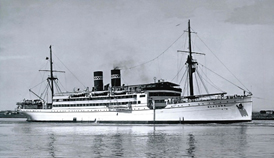

| Name | Role | Result of Bombing Raid, 19 February 1942 |
| HMAS Kuru | Auxiliary Patrol Boat | Undamaged |
| Lighter of unknown origin | ||
| SS Barossa | General cargo | Damaged by bomb
|
| MV NEPTUNA | Cargo motor vessel | Sunk alongside Stokes Hill Wharf. She had been unloading war supplies and ammunition including depth charges |
Vessels Laying at Anchor
The following vessels were laying at anchor in the roads at time of the first and second air raids. A summary of the employment of these vessels prior to the attack and their subsequent history is provided in the Annex to this paper.
| Name | Role | Result of Bombing Raid, 19 February 1942 |
| HMAS Warrego II | Grimsby Class Sloop | Undamaged |
| HMAS Swan II | Grimsby Class Sloop | Slightly damaged in the first day raids |
| HMAS Deloraine | Bathurst Class Minesweeper | Undamaged |
| HMAS Platypus I | Base Depot Vessel
|
Damage to engine room the result of near misses which sunk Mavie which was alongside at the time. |
| Mavie | Channel Patrol Boat | Sunk by shock from near mises. The crew of 4 escaped without injury. |
| HMAS Katoomba | Bathurst Class Minesweeper | Undamaged |
| SS Zealandia | Troop transport and resupply ship | Sunk by bombs |
| USS Peary | Clemson Class Destroyer | Sunk with the loss of 91 lives. |
| Supply Hulk Kelat | Coal Hulkj | Sank slowly after a near miss on 19 Feb 42 and machine gun strafing several days after the initial attack. |
| USS William B Preston | Clemson Class Destroyer | Suffered damage and lost three PBY aircraft. |
| SS Admiral Halstead | US flagged support ship carrying aviation fuel. | Damaged but did not catch fire. |
| SS Portmar | US flagged cargo vessel | Heavily damaged and run aground to save her from sinking. |
| HMAHS Manunda | Hospital Ship | Minor damage |
| SS Mauna Loa | US supply ship | Sunk |
| USAT Meigs | US supply ship | Sunk |
| MV Tulagi
|
Cargo vessel | Undamaged but was beached to save her from further attacks and possibility of sinking. Refloated on 20 February 1942. |
| MV British Motorist | RN Oil Tanker | Sunk by 2 direct bomb hits whilst refuelling USS Perry. |
| HMAS Kookaburra | Boom defence and and examination Vessel | Undamaged |
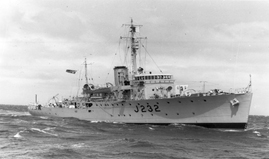
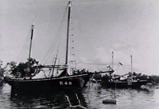
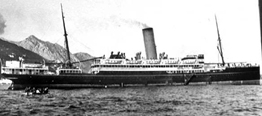
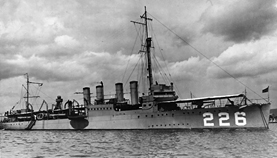
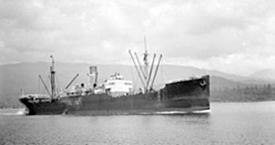
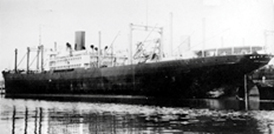
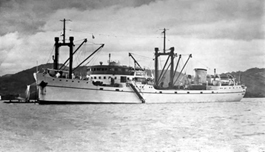
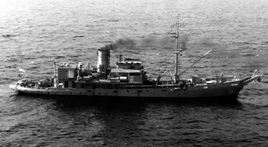
Other vessels in the Vicinity of Darwin on 19 February 1942
Official records show there was a significant number of Royal Australia Navy minor war vessels (commissioned and non-commissioned in or around the Port of Darwin on 19 February 1942. These are listed in the following table.
| Minesweepers | Patrol Boats | Luggers | Boom Defence Vessels |
| HMAS Warrnabool | HMAS Winbah | HMAS Ibis | HMAS Kangaroo |
| HMAS Townsville | HMAS Nereus | HMAS Medic | HMAS Krangi |
| HMAS Tolga | HMAS Coongoola | HMAS Red Bill | HMAS Koala |
| HMAS Terka | HMAS Kiara | HMAS St Francis | HMAS Kompartoo |
| Examination Vessels | HMAS Mako | HMAS Moruya | HMAS Kara Kara |
| HMAS Larrakia | HMAS Vigilant | HMAS Griffioen | Coasters |
| HMAS Southern Cross | HMAS Mako | HMAS Arthur Rose | HMAS Gunbar |
| Ketch | Tugs | HMAS Malanda | Lighters |
| HMAS Sulituan | HMAS Wato | Mars | HMAS Kalaroo |
| HMAS Chinampa | Plover | Yampi Lass | |
| Floating Docks | |||
| AD1001 |
War Time Sites in and Around Darwin
An objective of our tour was to visit all the war time sites in and around Darwin. We started in Darwin City visiting the following; the Oil Fuel Tunnels, Stokes Hill Wharf, the Military Museum at East Point and the 9.2” gun emplacements. We then travelled south to the “Charles Darwin National Park” where one can walk through the WWII ammunition bunkers which were the responsibility of the RAAF. Further south towards Batchelor and Adelaide River there are many relics to be seen. These include an anti-aircraft site at what was known as the “Quarantine Battery” with 3.7” guns, a placement of four and the most complete site, 36 miles south. Then came 16 mile camp, the first such named camp using the mileage ex Darwin. This site was used by both the United States and Australian troops. It has been refurbished with a 2.5 km walking track across quite a steep ridge, where you can still view their scraps and trenches in the bush, 17.5 mile camp site is just down the road. Next comes the myriad of war time airstrips, Sattler, Strauss at 27 mile the last surviving and almost intact pursuit fighter base in the Territory, Coomalie Creek, Batchelor, Gould (adjacent Batchelor) and Pell at 65 mile south.
Adelaide River is the site of the Commonwealth War Graves Commission Cemetery where there are 434 military burials. I found 16 sailors’ plaques, two of which were killed in action (KIA) on the 19 February 1942 during the Japanese raids. Coincidentally, they both had the surname MOORE and both served on Darwin’s Boom Defence vessels in Darwin on the first day of the raids. 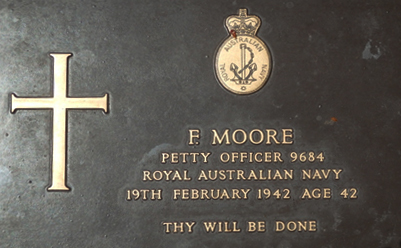
One was Petty Officer Seaman Frank MOORE RAN (pre-war), official number 9684, aged 42, born 22nd November 1899 in Croydon England, joined the Royal Navy 27th January 1920 at 20 years of age. Served on HMA Ships Tasmania, Melbourne, Cerberus, Platypus, Adelaide, Penguin, Australia, Vampire, Stuart, Brisbane, Sydney, then a second posting to Adelaide, Penguin then onto Melville and finally Kara Kara (Boom Defence Vessel – Darwin) where he served from 13th July 1941 until KIA on the 19 February 1942. It is noted on his Service Certificate he actually passed away on HMAHS Manunda in the Port of Darwin on 19 February 1942.
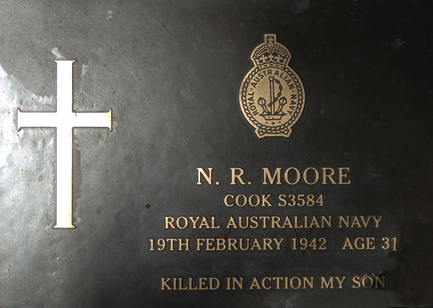
The second sailor was Cook Norman Richard MOORE, official number S3584, born 3 February 1911. He joined the RANR as a war time enlistment on 6 September 1939 (a very early volunteer), his postings were to Penguin, Cerberus, Penguin for a second time, Melville and HMAS Kangaroo (Boom Defence Vessel – Darwin) between 24 December 1940 to 19 February 1942 when killed in action. His mother was paid 24 shillings per fortnight as a war pension commencing 20 February 1942. He was originally buried in Berrimah Grave C.1 reference 446/201/692 on 2 September 1942 until reburied at Adelaide River CWGC Cemetery.
Rest in Peace my fellow sailors.
References:
- navy.gov.au/history ships details and photographs of same
- CWGC Adelaide River Cemetery plaques and information – credit author
- USS Peary gun Memorial photo credit – author
- Japanese submarine 1-124 by Tom Lewis author of “I-124”
- Military Museum East Point Darwin reference material from displays
- NT Parliament Library Bombing of Darwin – Battle of Darwin display
Annex
Details of Vessels in the Port of Darwin 19 February 1942
HMAS Kuru
HMAS Kuru was an auxiliary patrol boat Pennant number 83 – built at Balmain Sydney by J Beattie & Sons in 1938 for the NT’s Administration for Customs & Police duties. Her name in local indigenous language is “The Eye”. The RAN requisitioned her on 8th December 1941 as a tender to HMAS Platypus. Displaced 55 tons and wooden built. Speed 13 knots, armament 2 x 20mm Oerlikons, 1 x Vickers Machine Gun, 1 x Lewis Machine Gun, 2 x depth charge chutes. In May 1943 Kuru was under the command of Lieutenant Joe Joel RANR inaugurated the naval supply run between Darwin & Betano in Timor (Operation Hamburger) delivering men and supplies to Sparrow Force. “Kuru” was the transport for “Z Force” men and supplies (Operation Lizard), she also evacuated many civilians and servicemen off Timor on multi occasions. On the 01st December ‘42 in company with HMAS Armidale she went again into Timor to evacuate troops but got separated from Armidale. They were attacked by a large number of Japanese aircraft (official number states 44). “Kuru” was damaged by shrapnel and lost a boat being towed with a direct hit. She arrived back in Darwin 3rd December 1942, but Armidale was lost in the attack 27th January 1943 “Kuru” proceeded to Wessel Islands and collected the survivors from the sinking and strafing of HMAS Patricia Cam. Decommissioned 22nd October 1943 and spent the war on local patrol and Boom Defence duties. A warrior to the last!
SS Barossa
A 4,265 GRT cargo vessel owned by the Adelaide Steamship Co. and built in Dundee Scotland in 1938 – she was damaged in the raid. Post WWII she was renamed “Cronulla” and was damaged in a typhoon out of Hong Kong and was scrapped in Hong Kong in 1969.
MV Neptuna
MV Neptuna was a 5,952 GRT Cargo vessel motor vessel, originally launched as MV Rio Panuco in 1924, renamed Neptun in 1931 and then to Neptuna in 1935. Built by Friedrich Krupp Germaniawerft of Keil Germany and operated by Flensburger Dampfer & Company between 1924-1931. Renamed Neptuna also in 1931 and operated by Norddeutscher Lloyd Line between New Guinea and Hong Kong. Purchased in 1935 by Burns Philp & Company until sunk alongside Stokes Hill wharf on the 19th February 1942 Port Darwin whilst unloading war supplies and ammunition including depth charges.
HMAS Warrego II
HMAS Warrego II a Grimsby Class Sloop U 73 built at Cockatoo Dockyard Sydney, laid down 15th May 1939, launched 10th February 1940 by Mrs Pattie Menzies, wife of the Prime Minister. Commissioned 22nd August 40, decommissioned 15th August 1963. First CO Cmdr R V Wheatley RAN, displacement 1,575 tons fully loaded, speed 16.5 – 17 knots, crew 135, armament 4 x 4” open gun mounts, 4 x QF 3 pounders, 2 x depth charge throwers, 7 x 20mm Oerlikons, 2 x twin tube 21” torpedoes. She was sold on 2nd June 1965 to Metal Traders Australia Pty Ltd and broken up in 1966 in Sydney – undamaged in the raid.
HMAS Swan II
HMAS Swan II was a Grimsby Class Sloop U 74, built Cockatoo Dockyard Sydney, laid down 01st May 1935, launched 28th March 36, commissioned 21st January 1937, decommissioned 20th September 62. First CO Cmdr Roy R Dowling RAN, displacement, speed, complement, armament similar to HMAS Warrego II her sister ship – slightly damaged in the first day raids.
HMAS Deloraine
HMAS Deloraine was a Bathurst Class (Corvette) – Minesweeper J 232 built at Morts Dock & Engineering Co Ltd Sydney, laid down 10th March 1941, launched 26th July 1941 by Dame Mary Hughes, the wife of the then Minister of the Navy. Commissioned 22 November 1941, decommissioned 30th June 1948, displacement 650 tons, speed 15 knots, armament 1 x 4” Mk XIX gun, 2 x 20mm Oerlikons, 1 x 40mm Bofor plus Machine Guns for the use of!, complement 85. She came through the first bombing raid undamaged. “Deloraine” was also one of four ships (USS Edsall, HMAS Lithgow, Katoomba) which were credited with sinking the Japanese Submarine I-124 on or around 20th January 1942 off Bathurst Island, north of Darwin.
HMAS Platypus I
HMAS Platypus I had no pennant number allocated at its commissioning. It was originally a Submarine Depot Ship for our six J Class in the late 20’s. Built by John Brown & Co Ltd Clydebank Scotland, laid down 14th October 1914, launched 28th October 1916 by Mrs Fisher, the wife of the Australian High Commissioner to the UK. Displacement 3,476 tons, commissioned 25th March 1919, speed 15.5 knots, armament 1 x 4” low angle and 1 x 4” high angle gun, . In 1929 when ships were being paid off, “Platypus” became a Depot ship at Garden Island but also acting as Depot ship for the J Class submarines that were still operating (x 4 as 2 had been returned to the RN). She was paid off on the 15th August 1929 and recommissioned the next day as HMAS Penguin, and continued to serve as a Depot Vessel until 26th February 1941, when recommissioned back to her original name of “Platypus”. In May 1941 she proceeded to Darwin and on the 19th February 1942 took three near misses, whilst the “Lugger Mavie” that was alongside was sunk. “Platypus” took damage to her engine room and was inoperative for some time until repaired. She remained Base Depot ship until 01st January 1943 when she sailed for Cairns where she resumed Base Depot ship duties until May 1944. Platypus was decommissioned on 13th May 1946.
Mavie
Mavie was a Channel Patrol Boat, 19 tons auxiliary of wooden Lugger structure, built in 1903 in Fremantle. As she was owned by a Japanese national, a Mr Jiro Muramats, it was requisitioned in December 1941. “Mavie” took a near miss whilst alongside Platypus, the crew of 4 escaped without injury. In 1959-60 along with the MV Neptuna was salvaged by Fujita Salvage Company. Yes by the Japanese who actually sunk both vessels…….such is life !
HMAS Katoomba
HMAS Katoomba was a Bathurst Class (Corvette) – Minesweeper J 204 built by Poole & Steel Ltd at Balmain Sydney, laid down 9th September 1940, launched 16th April 1941 by a Mrs Lloyd Deputy Mayoress of Katoomba NSW. Commissioned 17th December 1941, decommissioned 2nd August 1941. Her other specifications are similar to HMAS Deloraine, she came through day one’s air raid undamaged.
MV Zeelanda
MV Zeelanda was owned and operated by Huddart Parker Line Melbourne, built by John Brown & Co Clydebank Scotland, launched 20th November 1909, completed May 1910, nicknamed “Zed” or plain “Z”, 6,683 Gross tons, speed 15 knots, could carry 800 troops and 1,800 in war supplies. She served as a troop transport in both wars and carried the Australian 8th Division at one deployment early in WWII. Her crew were the last to see HMAS Sydney before she was lost in the engagement with the raider Kormoran HSK – 8 with all hands. Zeelanda was sunk.
USS Peary
USS Peary DD 226 was a Clemson Class Destroyer USN, named after Rear Admiral Robert Edwin Perry USN (6th May 1856 – 20th February 1920) an American explorer of the Arctic, he’s best known for claiming to have reached the geographic North Pole on 6th April 1909. USS Perry was built by William Cramp & Sons of Philadelphia, laid down 9th September 1919, launched 6th April 1920, commissioned 22nd October 1920, of 1,190 tons, speed 35 knots, complement 101 Officers and men, armament 4 x 4” guns, 1 x 3” gun, 12 x 21” torpedo tubes. The USS Peary was in the Philippines when Pearl Harbor was attacked, she was also attacked by Japanese aircraft on the 10th December 1941 in Philippine waters whilst alongside and took a direct hit forward in the superstructure that killed 8 crew. “Peary” was towed out of her berth and the fires caused by the hit extinguished by the USS Pillsbury (DD 227) as sister ship and AM-35 Whippoorwill. The CO Cmdr H H Keith was wounded by an exploding torpedo and relieved by Cmdr J M Berringham. “Peary” eventually made it to the safety of Port Darwin only to be sunk in the Japanese raid of Thursday 19th February 1942. There are 91 names on the Roll of Honour attached to a salvaged 3” gun from this “Four Funnelled Flipper’ as they were referred to by those that served on similar lend lease ships in Royal Naval service during WWII.
Supply Hulk Kelat
Supply Hulk Kelat was an 1849 tons, iron hulled, fully rigged three masted sailing ship, built in Stockton-on-Tees England in 1881, builder Richardson Duck & Company, launched 31 March 1881, completed May 1881, requisitioned into RAN service in 1941. Originally she sailed the London-Australia route until damaged in a severe storm and was condemned in Melbourne on the 9th July 1914. Sold to Mcllwrath McEachern Property Ltd who converted her into a coal hulk. Sometime after, she was renamed her original given name “Kelat”. In February 1942 she was towed from Fremantle to Darwin fully loaded with coal. Sunk on the 19th February 1942, she went down slowly after a near miss and machine gun bullets from strafing Japanese aircraft a few days post the initial attack.
USS William B Preston
USS William B Preston DD 344/AVP-20/AVD-7 was of the same Class as USS Perry a Clemson Class Destroyer and named after the then Secretary of the Navy and Senator, William B Preston. She was known by her crew as the “William B”. Built at the Norfolk Naval Shipyard, laid down 18th November 1918, launched 9th August 1919, commissioned 23rd August 1920, decommissioned 6th August 1945. Displacement 1,308 tons, speed 35 knots, complement 221 Officers & men. Armament 4 x 4” guns, 1 x 3” gun, 12 x 21” torpedo tubes, The “William B” received the same punishment as the “Perry” days after the attack on Pearl Harbor. She was designated and being used as a Seaplane Tender, and lost two PBY’s (Catalinas) at anchor in one attack. The remaining PBY’s were sent ahead and the “William B” made for Darwin. On the morning of the 19th the CO Lt. Cmdr Etheridge Grant USN was ashore visiting the US Consul when the Japanese struck, he made it back to his ship but she suffered damage. Also two PBY’s were lost and a third at anchor outside the port at East Point.
SS Admiral Halstead
There’s little information on SS Admiral Halstead in open source other than she was built in 1921 and was a merchant US flagged ship carrying 14,000 drums of aviation fuel. US Army volunteers were able to unload its cargo and although damaged in the raid miraculously didn’t catch fire – someone was looking after her crew and volunteer unloaders.
SS Portmar
SS Portmar: A United States flagged merchantman originally named “Centaurus”, built by North West Steel in 1919, changed name to “Portmar” in 1930, launched 17th November 1919, completed in December 1919, GRT 5,551, DWT 8,800. She was chartered by the US Department of War to carry supplies to the Philippines but found herself retained in Australia when the Japanese invaded the Philippines and used to carry reinforcements from Darwin to Timor. The vessel was attacked by Japanese aircraft enroute to Timor on the 18th February 1942 and turned back to Darwin, so found herself at anchor in Darwin on the morning of the 19th. The “Portmar” was heavily damaged and run aground to save her from sinking. After the attack the ship was refloated 6th April 1942 and towed to Sydney for extensive repairs. The US Army then purchased her and placed it back in service as an Army transport. In June 1943 she sailed in Convoy GP 55 and was torpedoed off Smoky Cape along with another convoy vessel LST-469 by the Japanese submarine I-174. Because of her highly explosive cargo she was abandoned and sunk quickly (within ten minutes of the hit), the Portmar was the last ship lost to any Japanese submarine action (they say) in Australian waters during WWII.
HMAHS Manunda
Hospital Ship – HMAHS Manunda: Originally named TSMV Manunda (TS-twin screw) owned by the Adelaide Steamship Company (ASS) Melbourne, built by William Beardmore & Co. Dalmuir Scotland. Launched 27th November 1928, completed 16th April 1929, GRT 9,115 tons, speed 15 knots, could carry 312 passengers and designated a passenger-cargo ship. When war was declared “Manunda” was fitted out as a DEMS (Defensively Equipped Merchant Ship), she was converted to a Hospital Ship and entered service in that role on the 22nd July 1940 under the command of Merchant Captain James Gordon the pre-war Commodore of the ASS fleet. She received some damage in the initial raids on Darwin. Post WWII she was sold to a Japanese Co. “Okadagumi Line” and scrapped in 1957 in Osaka Japan.
SS Mauna Loa
SS Mauna Loa was originally named “West Conob” when laid down in 1919 for the United States Shipping Board (USSB) part of the West series of ships, steel hulled cargo ship built on the West Coast USA for the WWI effort. She was the 14th such ship built by the Los Angeles Shipbuilding & Dry Dock Co. at San Pedro California, GRT 5,899 tons. She was owned by a number of companies, Pacific Mail Steamship Co, and circumnavigated the world twice by 1921, then to South America for Swayne & Hoyt Lines in 1925. In 1934 Swayne & Hoyt was absorbed into Oceanic & Oriental Navigation Co. And was name changed to the “Golden Eagle”. Eventually this Company was also absorbed by Matson Navigation Company and operated between the West Coast USA and Hawaii and then came another name change to “Mauna Loa” to give her a Hawaiian-sounding title. Before the US entered WWII the US Department of War chartered the vessel to carry supplies into the Philippines, the vessel was part of the convoy en-route to Timor that turned back to Darwin on the 18th February 1942 and found herself in Port Darwin on the 19th – unfortunately she was sunk.
USAT Meigs
USAT Meigs was originally named “West Lewark” (1921-22), laid down 30th July 1920, launched 24th February 1921, acquired by the US Army in 1922 and renamed “Meigs”. Like the Mauna Loa she was built for the United States Shipping Board (USSB) at GRT 7,358 tons and was one of the few merchant ships retained between the war years. Before WWII she was designated number AK-34 but never sailed under that pennant number due to the US governments change of mind? This vessel was part of the “Pensacola Convoy” to reinforce the Philippines but was held in Fiji when it was clear the Japanese were already invading the Philippines. Despite the US military endeavouring to re-route the convoy back to the US, the President made the decision to send it on to Australia and to try and resupply the Philippines ex Australia. “Meigs” was escorted to Darwin by the USS Houston (later to be sunk in company with HMAS Perth). She was also used to try and resupply Timor, but was sunk on the 19th February 1942. Much of her cargo lies in Port Darwin, munitions, railway tracks (rails), Bren Gun Carriers, trucks of various varieties – all intended for “Sparrow Force” on Timor.
MV Tulagi
MV Tulagi was owned by Burns Philp and registered in Hong Kong, launched 30th March 1939, completed July 1939, she was a basic cargo vessel, built by Hong Kong & Whampoa Dockyard of Hong Kong, displacement 2,550 DWT. She survived the Darwin bombing on the 19th February but was beached to save her from any further attacks and the possibility of sinking, refloated on Friday 20th February 1942. “Tulagi” was also part of the turned back convoy on the 18th February. Unfortunately, her luck ran out on 28th March 1944 at 00:10 when torpedoed by the German submarine U-532 under the command of Kapitan Ottoheinrich Junker whilst enroute between Sydney and Colombo under the command of Captain Leonard (Dusty) Millar. She was carrying 1,800 tons of flour and 380 bags of mail. Her total crew was made up of 15 Officers, 26 Indian Seamen, 7 Malay and 5 RANR gunners = 54 in total, only 15 out of her crew survived the sinking. They were 11 Australians, 3 Malays and 1 Indian.
MV British Motorist
MV British Motorist was a tanker of 6,891 Long tons, built by Swan Hunter & Wigham Richardson at Newcastle upon Tyne UK, for the British Tanker Company. Launched 14th August 1924, crew 61, on the morning of the raid (19th Feb 42) she was on charter to the Royal Navy. She was hit by two direct aerial bombs whilst refuelling USS Perry. Her master Captain C Bates and 2nd Radio Officer were killed in the blast. In 1959-60 the Fujita Salvage Co, raised the fore and aft sections leaving the engine room below as it was too heavy to lift, they then welded both sections together and towed them back to Japan where they were broken up for scrap. The engine room lies at co-ordinates 12 degrees 28 minutes 96 seconds South and 130 degrees 50 minutes 33 seconds East.
HMAS Kookaburra
HMAS Kookaburra: Modified Net Class Boom Defence vessel A 331 built at Cockatoo Dockyard Sydney, laid down on 4th April 1938. Launched 29th October 1938, commissioned 28th February 1939, decommissioned 3rd December 1958, 533 tons, speed 9.5 knots, complement 32, armament 1 x 3” HA/LA gun, 2 x .303” Maxim machine guns. On the 9th April 1940 proceeded to Darwin and assumed the dual role of both a Boom Defence Vessel and Examination Vessel. Other than for a refit in Brisbane between September 1942 and February 1943 she served out the entire war in Darwin and was declared for disposal on 24th June 1965. As a Naval League Cadet, the author served onboard her at TS Australia which was then Boom Defence Waverton, commissioned as HMAS Waterhen on the 5th December 1962 with the arrival of the six Ton Class Minesweepers joining the Royal Australian Navy.




